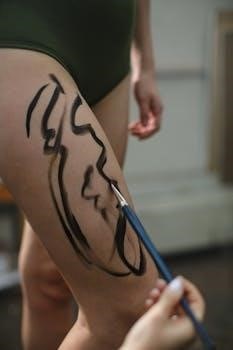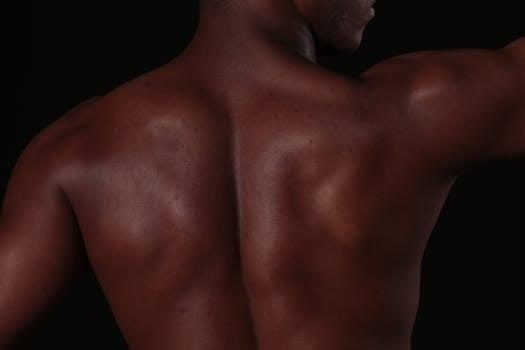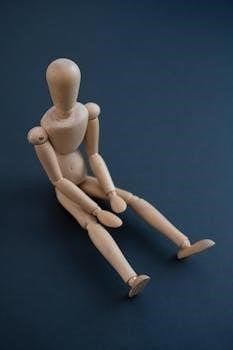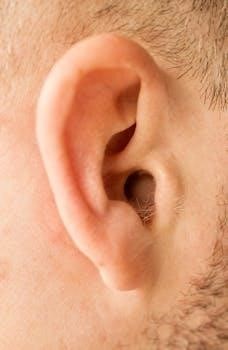Human anatomy drawing is essential for artists seeking realism and dynamic figures. Understanding the skeletal structure and musculature allows for accurate representation of form and movement. This knowledge enhances artistic expression and brings figures to life.
The Importance of Anatomy in Art
In art, anatomy is more than just knowing bones and muscles; it’s about understanding how they interact to create form and movement. A strong grasp of human anatomy allows artists to depict figures realistically, capturing the nuances of posture, gesture, and expression. By studying anatomy, artists can avoid common mistakes in proportion and structure, resulting in more believable and engaging artwork. Anatomical knowledge provides a foundation for artistic license, allowing artists to exaggerate or stylize figures with intention and control. Ultimately, understanding anatomy elevates the quality and impact of figurative art.
Understanding the Skeletal Structure
The skeleton is the foundation of the human body, providing its basic shape and support. Artists must understand its structure to accurately portray form and movement in their drawings, ensuring realistic figures.
Key Bones for Artists to Know
For artists, understanding key bones is crucial for accurate figure drawing. The skull dictates head shape, while the ribcage and pelvis form the torso’s foundation. The spine’s curvature influences posture and movement. Clavicles and scapulae affect shoulder and arm positioning. Knowing the humerus, radius, and ulna in the arm, along with femur, tibia, and fibula in the leg, is essential for limb articulation. These bones dictate the body’s form, impacting how muscles attach and influence surface anatomy, aiding in realistic and dynamic figure representation in art.

Muscular System and its Influence on Form
The muscular system dictates surface form in figure drawing. Understanding muscle attachments and groupings allows artists to depict realistic contours. This knowledge adds depth and dynamism to artistic representations of the human figure.
Surface Anatomy and Muscle Groupings
Surface anatomy involves observing how muscles manifest beneath the skin, influencing the body’s contours. Artists must learn to recognize key muscle groupings and their effect on form. Understanding how muscles attach to bones and interact during movement is crucial. Observing live models, studying anatomical references, and practicing consistently will improve artists ability to accurately depict surface anatomy. By simplifying muscle forms and focusing on their overall impact, artists can create dynamic and believable figure drawings. Mastering surface anatomy elevates artistic skill and enhances the realism of human figure representations in art. This study helps artists capture the subtleties.
Proportions and Body Ratios
Understanding proportions and body ratios is fundamental to drawing the human figure accurately. Artists need to study the relationships between different body parts to create balanced and realistic representations in their artwork.
Ideal vs. Realistic Proportions
Artists often grapple with the distinction between ideal and realistic proportions when drawing the human figure. Ideal proportions, frequently based on classical standards, represent an idealized form. Realistic proportions, on the other hand, reflect the natural variations found in actual human bodies. Accurate anatomical drawing requires understanding both.
By studying live models and observing diverse body types, artists can develop a keen eye for realistic proportions. Incorporating these observations into their artwork results in more believable and engaging depictions of the human form. Balancing ideal and realistic proportions is key.

Drawing the Torso
Accurately drawing the torso requires a solid understanding of its underlying structure. The ribcage and pelvis serve as foundational elements, dictating the shape and movement of the upper body. Mastering these forms is crucial.
Ribcage and Pelvis as Foundation
The ribcage and pelvis are the essential structural components of the torso, serving as the anchor points for muscles and dictating the body’s overall form. Visualizing these bony structures beneath the surface is critical for accurate anatomical drawings. The ribcage protects vital organs and influences the shape of the chest, while the pelvis supports the spine and connects to the legs. Understanding their individual shapes and how they relate to each other is essential for creating realistic and dynamic poses. Artists should study simplified forms of the ribcage and pelvis.
Arms and Legs⁚ Structure and Movement
Understanding the bony structure and musculature is paramount for accurately depicting limbs. Studying limb articulation allows for dynamic and realistic poses. Focus on the major muscle groups and their influence on surface form.
Understanding Limb Articulation
To master drawing arms and legs, a deep understanding of how limbs connect and move is crucial. Pay attention to the shoulder and hip joints, elbows and knees; these are key to dynamic poses. Consider the range of motion for each joint, and how muscles work in coordination to achieve movement. Observe how the underlying skeletal structure influences the surface form during different actions. Practice drawing limbs in various positions to internalize these principles. This understanding will elevate the realism and believability of your figure drawings, making them more expressive and lifelike.

Hands and Feet⁚ Complex Anatomy
Hands and feet, though small, possess intricate anatomy. Mastering their forms is vital for realistic figure drawing. Understanding the underlying bone structure and muscle arrangement unlocks expressive potential in your art.
Simplifying Forms for Drawing
When approaching the complex anatomy of hands and feet, simplification is key. Begin by identifying basic shapes and volumes that represent the underlying structure. Break down the hand into the palm, fingers, and thumb, focusing on their relative proportions. Similarly, visualize the foot as a combination of the heel, arch, and toes.
By reducing these complex structures to simpler forms, you can establish a solid foundation for your drawing. Gradually add detail, paying attention to the contours and surface anatomy. This approach allows you to capture the essence of the hand and foot without getting bogged down in intricate complexities.
The Head and Facial Anatomy
Drawing the head requires understanding the underlying skull structure and facial muscles. Mastering these elements is crucial for creating realistic and expressive portraits. Studying proportions and landmarks enhances accuracy.
Skull Structure and Facial Muscles
The skull provides the foundational structure for the head, influencing its overall shape and proportions in human anatomy. Key features include the cranium, which protects the brain, and the facial bones, which define individual characteristics. Facial muscles attach to the skull and skin, enabling a wide range of expressions. Understanding the origin, insertion, and action of these muscles is essential for portraying realistic emotions. Artists should study the masseter, temporalis, orbicularis oculi, and orbicularis oris to accurately depict facial expressions and subtle nuances, ensuring lifelike and believable portraits through careful observation and anatomical knowledge.

Resources for Anatomy Drawing
Numerous resources exist to aid in anatomy drawing, from books detailing skeletal and muscular systems to online PDFs offering visual guides. These resources provide invaluable insights for artists seeking anatomical accuracy.
Recommended Books and PDFs
For delving deeper into human anatomy for art, several books and PDFs stand out. Giovanni Civardi’s “Drawing Human Anatomy” offers detailed illustrations and structural insights. Numerous PDF guides are available online, often breaking down the body into simple forms. “Classic Human Anatomy” is an essential companion that gives a deeper understanding of the human form. Resources emphasizing the relationship between muscle structure, form, and artistic representation are invaluable. Look for materials covering proportions, poses, gestures, lighting, and toning, crucial for realistic and expressive figure drawing. Exploring comparative anatomy, observing live models, and drawing self-portraits are also effective learning methods;
Practicing and Improving Your Skills
Consistent practice is key to mastering anatomical accuracy. Observe people, draw self-portraits, and work with live models. Focus on understanding forms, proportions, and poses to refine your skills.
Exercises for Anatomical Accuracy
To improve anatomical accuracy, begin with gesture drawings to capture the essence of a pose. Then, focus on skeletal landmarks and muscle groupings, using references like anatomy books and PDFs. Practice drawing from various angles and perspectives to understand how forms change in space. Pay close attention to proportions and body ratios, comparing your drawings to reference images. Create studies of individual body parts, such as hands and feet, to master complex anatomy. Finally, consistently seek feedback and critique to identify areas for improvement and refine your observational skills for drawing the human form.